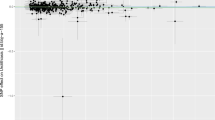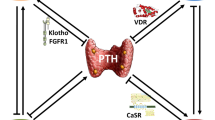Abstract
Purpose
The purpose of this study was to assess the relationship between osteoporosis and the angiotensin-converting enzyme (ACE) gene insertion/deletion (I/D) polymorphism in a Turkish population.
Methods
The study group consisted of 238 unrelated women with osteoporosis and 124 unrelated healthy female controls. All participants, patients and healthy controls, were of Turkish origin from the central region of Turkey. Genomic DNA was isolated from whole venous blood samples using a commercial DNA isolation kit. The ACE gene I/D polymorphism was analysed by polymerase chain reaction and gel electrophoresis.
Results
Frequencies of the DD, ID and II genotypes in the patients were 44.5, 41.2 and 14.3 %, and in the controls they were 25.0, 51.6 and 23.4 %, respectively. A significant difference was observed between patients and controls according to genotype frequency (p = 0.001). D and I allele frequencies of the I/D polymorphism were 65.1 and 34.9 % in the patient group and 50.8 and 49.2 % in the control group, respectively (p < 0.001).
Conclusion
The ACE gene I/D polymorphism could be a genetic factor associated with osteoporosis.
Zusammenfassung
Ziel
Ziel dieser Studie war es, die Verbindung zwischen Osteoporose und dem Insertion/Deletion(I/D)-Polymorphismus des Angiotensin-konvertierenden-Enzym(ACE)-Gens in einer türkischen Population zu untersuchen.
Methoden
Die Studiengruppe bestand aus 238 nichtverwandten Frauen mit Osteoporose und einer Kontrollgruppe mit 124 nichtverwandten gesunden Frauen. Alle Teilnehmenden, die Patienten und die gesunde Kontrollgruppe, stammten aus der Zentraltürkei. Mittels eines handelsüblichen DNA-Isolationskits wurde aus venösen Blutproben genomische DNA entnommen. Der ACE-I/D-Polymorphismus wurde mittels Polymerase-Kettenreaktion und Gelelektrophorese analysiert.
Ergebnisse
Die Häufigkeiten der Genotypen DD, ID und II in den Patienten waren 44,5, 41,2 und 14,3 %, in der Kontrollgruppe betrugen sie 25,0, 51,6 und 23,4 %. Es wurde ein signifikanter Unterschied zwischen den Patienten und der Kontrollgruppe bezüglich der Genotyp-Häufigkeit (p = 0,001) beobachtet. Die Häufigkeiten der Allelen D und I der I/D-Polymorphismen betrugen 65,1 und 34,9 % in der Patientengruppe bzw. 50,8 und 49,2 % in der Kontrollgruppe (p < 0,001).
Conclusion
Beim I/D-Polymorphismus des ACE-Gens könnte es sich um einen genetischen Faktor handeln, der mit Osteoporose assoziiert ist.
Similar content being viewed by others
References
Genant HK, Cooper C, Poor G et al (1999) Interim report and recommendations of the World Health Organization task-force for osteoporosis. Osteoporos Int 10:259–264
Cooper C, Melton LJ (1992) Epidemiology of osteoporosis. Trends Endocrinol Metab 3:224–229
Gennari L, Becherini L, Falchetti A et al (2002) Genetics of osteoporosis: role of steroid hormone receptor gene polymorphisms. J Steroid Biochem Mol Biol 81:1–24
Soroko SB, Barrett-Connor E, Edelstein SL, Kritz-Silverstain D (1994) Family history of osteoporosis and bone mineral density at the axial skeleton: the Rancho Bernardo study. J Bone Miner Res 9:761–769
Diaz MN, O’Neill TW, Silman AJ (1997) The influence of family history of hip fracture on the risk of vertebral deformity in men and women: the European Vertebral Osteoporosis study. Bone 20:145–149
Hardy R, Cooper MS (2009) Bone loss in inflammatory disorders. J Endocrinol 201:309–320
Mendoza-Pinto C, Garcia-Carrasco M, Jimenez-Hernandez M et al (2010) Etiopathogenesis of Behcet’s disease. Autoimmun Rev 9:241–245
Ruiz-Ortega M, Lorenzo O, Suzuki Y et al (2001) Proinflammatory actions of angiotensins. Curr Opin Nephrol Hypertens 10:321–329
Hubert C, Houot AM, Corvol P, Soubrier F (1991) Structure of the angiotensin I-converting enzyme gene. Two alternate promoters correspond to evolutionary steps of a duplicated gene. J Biol Chem 266:15377–15383
Glenn KL, Du ZQ, Eisenmann JC, Rothschild MF (2009) An alternative method for genotyping of the ACE I/D polymorphism. Mol Biol Rep 366:1305–1310
Kritchevsky SB, Nicklas BJ, Visser M et al (2005) Angiotensin-converting enzyme insertion/deletion genotype, exercise and physical decline. JAMA 294:691–698
Tiret L, Rigat B, Visvikis S et al (1992) Evidence from combined segregation and linkage analysis, that a variant of the angiotensin I-converting enzyme (ACE) gene controls plasma ACE levels. Am J Hum Genet 51:197–205
Lehmann DJ, Cortina-Borja M, Warden DR et al (2005) Large meta-analysis establishes the ACE insertion-deletion polymorphism as a marker of Alzheimer’s disease. Am J Epidemiol 162:305–317
Yigit S, Tural S, Rustemoglu A et al (2013) DD genotype of ACE gene I/D polymorphism is associated with Behcet disease in a Turkish population. Mol Biol Rep 40:365–368
Nacak M, Erbagci Z, Buyukafsar K et al (2007) Association of angiotensin-converting enzyme gene insertion/deletion polymorphism with allergic contact dermatitis. Basic Clin Pharmacol Toxicol 101:101–103
Shehab DK, Al-Jarallah KF, Alawadhi AM et al (2008) Prevalence of angiotensin-converting enzyme gene insertion–deletion polymorphism in patients with primary knee osteoarthritis. Clin Exp Rheumatol 26:305–310
Kanis JA (1994) Assessment of fracture risk and its application to screening for postmenopausal osteoporosis: synopsis of a WHO report. WHO study group. Osteoporos Int 4:368–381
Swanberg M, McGuigan F, Ivaska KK et al (2010) Polymorphisms in the macrophage migration inhibitory factor gene and bone loss in postmenopausal women. Bone 47:424–429
Peng YM, Lei SF, Guo Y et al (2008) Sex-specific association of the glucocorticoid receptor gene with extreme BMD. J Bone Miner Res 23:247–252
Arko B, Prezelj J, Kocijancic A et al (2005) Association of the osteoprotegerin gene polymorphisms with bone mineral density in postmenopausal women. Maturitas 51:270–279
Rigat B, Hubert C, Alhenc-Gelas F et al (1990) An insertion/deletion polymorphism in the angiotensin I converting enzyme gene accounting for half the variance of serum enzyme levels. J Clin Invest 86:1343–1346
Shimizu H, Nakagami H, Morishita R (2012) Activation of osteoclasts by RAAS and strategy of target therapy on bone metabolic diseases. Nihon Rinsho 70:1524–1529
Shimizu H, Nakagami H, Osako MK et al (2008) Angiotensin II accelerates osteoporosis by activating osteoclasts. FASEB J 22:2465–2475
Perez-Castrillon JL, Justo I et al (2003) Relationship between bone mineral density and angiotensin converting enzyme polymorphism in hypertensive postmenopausal women. Am J Hypertens 16:233–235
Perez-Castrillon JL, Silvia J, Justo I et al (2003) Effect of quinapril, quinapril-hydrochlorothiazide, and enalapril on the bone mass of hypertensive subjects: relationship with angiotensin converting enzyme polymorphisms. Am J Hypertens 16:453–459
Altun B, Kiykim AA, Seyrantepe V et al (2004) Association between activated renin angiotensin system and bone formation in hemodialysis patients: is the bone mass genetically determined by ACE gene polymorphism? Ren Fail 26:425–431
Zhang Y, Qin L, Leung P, Kwok TCY (2012) The effect of angiotensin-converting enzyme inhibitor use on bone loss in elderly Chinese. J Bone Miner Metab 30:666–673
Bayram B, Sayın E, Gunes HV et al (2011) DD genotype of ace gene I/D polymorphism is associated in a Turkish study population with osteoarthritis. Mol Biol Rep 38:1713–1716
Inanir A, Yigit S, Tural S et al (2013) MTHFR gene C677T mutation and ACE gene I/D polymorphism in Turkish patients with osteoarthritis. Dis Markers 34:17–22
Yigit S, Inanir A, Tural S, Ates O (2012) Association of angiotensin converting enzyme (ACE) gene I/D polymorphism and rheumatoid arthritis. Gene 511:106–108
Compliance with ethical guidelines
Conflict of interest. B. Cakmak, A. Inanir, N. Karakus, O. Ates and S. Yigit state that there are no conflicts of interest.
All studies on humans described in the present manuscript were carried out with the approval of the responsible ethics committee and in accordance with national law and the Helsinki Declaration of 1975 (in its current, revised form). Informed consent was obtained from all patients included in studies.
Author information
Authors and Affiliations
Corresponding author
Rights and permissions
About this article
Cite this article
Cakmak, B., Inanir, A., Karakus, N. et al. Association between the ACE gene I/D polymorphism and osteoporosis in a Turkish population. Z Rheumatol 74, 346–350 (2015). https://doi.org/10.1007/s00393-015-1582-5
Published:
Issue Date:
DOI: https://doi.org/10.1007/s00393-015-1582-5




